List of reptiles of Minnesota

Blanding's turtle (scientific name Emys blandingii or Emydoidea blandingii) was the proposed state reptile of Minnesota.
Twenty-nine species of reptiles have been recorded in the US state of Minnesota, including 17 species of snakes, nine species of turtle, and three species of lizard.[1] Of those 29 species, two (Blanding's Turtle and the Wood Turtle) have been listed as Endangered by the International Union for Conservation of Nature, with another 19 listed as Least Concern and nine have not been evaluated.
Minnesota does not have an official state reptile. However, the Blanding's Turtle was proposed as the reptile of the state in 1998 and 1999.[2]
Snakes
| Common name | Scientific name | Conservation status | Description | Photograph |
|---|---|---|---|---|
| Eastern Yellowbelly Racer | Coluber constrictor flaviventris | Not Evaluated | Nonvenomous; adults reach 30–50 inches (76–127 cm); color varies from olive to blue to nearly black[3][4] | .jpg) |
| Ringneck Snake | Diadophis punctatus | Least Concern | 0Nonvenomous; adults reach 8–15 inches (20–38 cm); has a distinct yellow ring around the neck; color varies from slate gray to olive[5][6] | 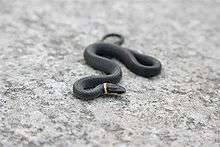 |
| Black Rat Snake | Elaphe obsoleta obsoleta | Not Evaluated | Nonvenomous; adults reach 42–72 inches (110–180 cm); adults appear shiny black; underbellies are white with black mottles[7] |  |
| Western Fox Snake | Pantherophis vulpinus | Least Concern | Nonvenomous; adults reach 36–54 inches (91–137 cm); color varies from tan to greenish brown with large black blotches[8][9] |  |
| Western Hognose Snake | Heterodon nasicus | Least Concern | Nonvenomous; adults reach 16–26 inches (41–66 cm); color varies from light yellow or olive color with systematic brown blotches[10][11] | 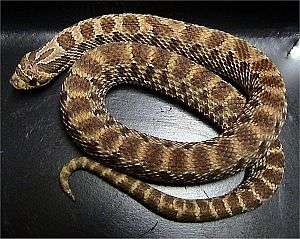 |
| Eastern Hognose Snake | Heterodon platyrhinos | Least Concern | Nonvenomous; adults reach 20–33 inches (51–84 cm); color varies from gray to brown with dark brown markings[6][12] |  |
| Eastern Milk Snake | Lamptopeltis triangulum triangulum | Not Evaluated | Nonvenomous; adults reach 24–36 inches (61–91 cm); repeating red, black-outlined blotches[13][14] |  |
| Smooth Green Snake | Opheodrys vernalis (sometimes Liochlorophis vernalis) |
Not Evaluated | Nonvenomous; adults reach 14–20 inches (36–51 cm); color varies from a uniform bright green to brownish green[15][16] |  |
| Northern Water Snake | Nerodia sipedon | Least Concern | Nonvenomous; adults reach 24–42 inches (61–107 cm); color varies from gray to reddish brown with dark brown crossbands[17][18] |  |
| Bullsnake | Pituophis catenifer sayi | Not Evaluated | Nonvenomous; adults reach 37–72 inches (94–183 cm); color varies from tan to brown with large brown or black spots[19][20] |  |
| Brown Snake | Storeria dekayi | Least Concern | Nonvenomous; adults reach 6–13 inches (15–33 cm); color varies from brown to reddish brown; two rows of dark spots across the back[21][22] |  |
| Northern Redbelly Snake | Storeria occipitomaculata | Least Concern | Nonvenomous; adults reach 8–10 inches (20–25 cm); color varies from gray-brown to reddish-brown[6][23] |  |
| Plains Garter Snake | Thamnophis radix | Least Concern | Nonvenomous; adults reach 15–28 inches (38–71 cm); similar to other garter snakes but with a yellow stripe down the side[24][25] |  |
| Eastern Garter Snake | Thamnophis sirtalis | Least Concern | Nonvenomous; adults reach 18–26 inches (46–66 cm); color varies from black to olive; usually has three yellowish stripes, one down the back and one along each side[26][27] | 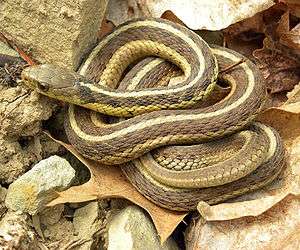 |
| Lined Snake | Tropidoclonion lineatum | Least Concern | Nonvenomous; adults reach 8–15 inches (20–38 cm); colors range from gray to black with a lighter color stripe down the middle of the back[28][29] |  |
| Timber Rattlesnake | Crotalus horridus | Least Concern | Venomous; adults reach 36–60 inches (91–152 cm); color varies from yellow to tan with dark markings on the back[30][31] | |
| Eastern Massasauga | Sistrurus catenatus | Least Concern | Venomous; adults reach 18–30 inches (46–76 cm); color varies from gray to gray brown with dark brown blotches down the middle of the back and along both sides[32][33] | 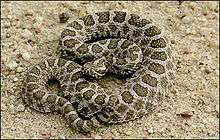 |
Turtles
| Common name | Scientific name | Conservation status | Description | Photograph |
|---|---|---|---|---|
| Blanding's turtle | Emydoidea blandingii | Endangered | Length of 6–9 inches (15–23 cm); yellow, long, narrow throat; domed carapace[34] | 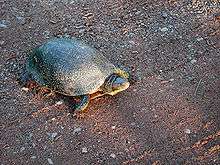 |
| Common snapping turtle | Chelydra serpentina | Least Concern | Length of 8–14 inches (20–36 cm); weight of 10–35 pounds (4.5–15.9 kg); shell color varies from tan to black [35] |  |
| False map turtle | Graptemys pseudogeographica | Least Concern | Length of 3–10 inches (7.6–25.4 cm); upper shell has yellow connected circles or lines; lower shell is greenish-yellow[36] |  |
| Northern map turtle | Graptemys geographica | Least Concern | Length of 6–10.75 inches (15.2–27.3 cm); fine yellow lines on a brown to olive shell[37] | 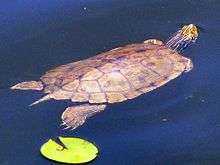 |
| Ouachita map turtle | Graptemys ouachitensis | Least Concern | Length of 6–10 inches (15–25 cm); ridge down the center of the shell; bright yellow lines on the head and limbs[38] | 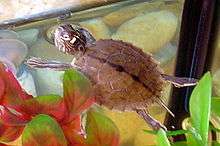 |
| Painted turtle | Chrysemys picta bellii | Least Concern | Length of 4–10 inches (10–25 cm); carapace color varies from tan to olive, with markings on the neck[39] | 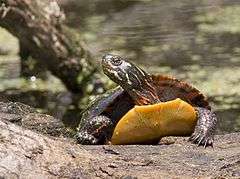 |
| Spiny softshell turtle | Apalone spinifera spinifera | Not Evaluated | Female length of 7–19 inches (18–48 cm); male length of 5–9.25 inches (12.7–23.5 cm); olive to brown, flexible, smooth shell[40] |  |
| Wood turtle | Glyptemys insculpta (formerly Clemmys insculpta) |
Endangered | Length of 5.5–8 inches (14–20 cm); rough, tan to gray carapace[41] | |
Lizards
| Common name | Scientific name | Status | Description[a] | Photograph |
|---|---|---|---|---|
| Five-lined skink | Eumeces fasciatus | Least Concern | Total length of 5–8.5 inches (13–22 cm); maximum body length of 3.4 inches (8.6 cm); brown to black body with short legs; juveniles have a blueish tail that turns to grey with maturation[42][43] |  |
| Prairie Skink | Eumeces septentrionalis | Least Concern | Maximum body length of 8.8 inches (22 cm); juveniles are blue, adults are tan with black stripes[44] | 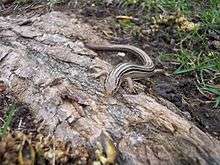 |
| Six-lined Racerunner | Cnemidophorus sexlineatus | Least Concern | Total length of 6–10.5 inches (15–27 cm); maximum body length of 3.4 inches (8.6 cm); light yellow to white stripes alternating with black stripes down back[45] | .jpg) |
Notes
- a Total length refers to the total length of the lizard. Maximum body length is the measurement from snout to cloaca of the lizard.
References
- General
- "Missouri Department of Conservation Online". Missouri Department of Conservation. Retrieved July 22, 2011.
- "The IUCN Red List of Threatened Species". International Union for Conservation of Nature. Retrieved July 22, 2011.
- Specific
- ↑ Coffin 1988, p. 326
- ↑ "Minnesota State Symbols—Unofficial, Proposed, or Facetious". Minnesota Legislature. Retrieved July 23, 2011.
- ↑ "Eastern Yellow-Bellied Racer". Missouri Department of Conservation. Retrieved May 15, 2011.
- ↑ Tennant 1998, p. 175
- ↑ Badger, David P.; Netherton, John (1999). Snakes. Stillwater, Minnesota: Voyageur Press. p. 36. ISBN 0-89658-408-9.
- 1 2 3 Martin, Glen (1998). National geographic's guide to wildlife watching. Washington, DC: National Geographic Society, Book Division. p. 313. ISBN 0-7922-7130-0.
- ↑ "Black Rat Snake". Missouri Department of Conservation. Retrieved May 15, 2011.
- ↑ "Western Fox Snake". Missouri Department of Conservation. Retrieved May 15, 2011.
- ↑ Paulson, Dave (2007). Northwood's Naturalist. Webster, Wisconsin. p. 140. ISBN 0-615-15430-1.
- ↑ Coffin 1988, p. 337
- ↑ Trutnau, Ludwig (1986). Nonvenomous snakes. Woodbury, New York: Barron's. p. 102. ISBN 0-8120-5632-9.
- ↑ "Eastern Hog-Nosed Snake". Missouri Department of Conservation. Retrieved May 15, 2011.
- ↑ "Species Information: eastern milksnake (Lampropeltis triangulum triangulum)". Virginia Department of Game and Inland Fisheries. Retrieved May 15, 2011.
- ↑ Kricher, John C.; National Audubon Society; National Wildlife Federation; Roger Tory Peterson Institute (1998). A field guide to eastern forests, North America. Boston, Massachusetts: Houghton Mifflin Harcourt. p. 380. ISBN 0-395-92895-8.
- ↑ "Smooth Green Snake". Missouri Department of Conservation. Retrieved May 15, 2011.
- ↑ Breckenridge 1944, p. 113
- ↑ "Northern Water Snake". Missouri Department of Conservation. Retrieved May 15, 2011.
- ↑ Bartlett, Richard D.; Tennant, Alan (2000). Snakes of North America: Western region. Houston, Texas: Gulf Publishing Company. p. 95. ISBN 0-87719-312-6.
- ↑ "Bullsnake". Missouri Department of Conservation. Retrieved May 15, 2011.
- ↑ Tennant 1998, p. 190
- ↑ Glenn, Thomas. "Species Profile: Brown Snake (Storeria dekayi)". University of Georgia. Retrieved May 15, 2011.
- ↑ Tennant 1998, p. 57
- ↑ "Northern Red-Bellied Snake". Missouri Department of Conservation. Retrieved May 15, 2011.
- ↑ "Plains Garter Snake". Missouri Department of Conservation. Retrieved May 15, 2011.
- ↑ Breckenridge 1944, p. 142
- ↑ "Eastern Garter Snake". Missouri Department of Conservation. Retrieved May 15, 2011.
- ↑ Tennant 1998, p. 67
- ↑ "Lined Snake". Missouri Department of Conservation. Retrieved May 15, 2011.
- ↑ "Lined Snake Tropidoclonion lineatum". OK Snakes. Retrieved May 15, 2011.
- ↑ "Timber Rattlesnake". Missouri Department of Conservation. Retrieved May 15, 2011.
- ↑ "Venomous Snakes of Ohio". Ohio Department of Natural Resources. Retrieved May 15, 2011.
- ↑ "Eastern Massasauga Rattlesnake". Missouri Department of Conservation. Retrieved May 15, 2011.
- ↑ "USFWS: Eastern Massasauga Fact Sheet". United States Fish and Wildlife Service. Retrieved May 15, 2011.
- ↑ "Blanding's Turtle Emydoidea blandingii" (PDF). Natural Heritage and Endangered Species Program. p. 1. Retrieved July 31, 2011.
- ↑ "Common Snapping Turtle". Missouri Department of Conservation. Retrieved July 31, 2011.
- ↑ "False Map Turtle". Missouri Department of Conservation. Retrieved July 31, 2011.
- ↑ "Common (Northern) Map Turtle". Missouri Department of Conservation. Retrieved July 31, 2011.
- ↑ "Ouachita Map Turtle". Missouri Department of Conservation. Retrieved July 31, 2011.
- ↑ Deal, Kevin H. (2002). Wildlife & natural resource management. Clifton Park, New York: Cengage Learning. p. 253. ISBN 0-7668-2681-3.
- ↑ "Spiny Soft-shell Turtle (Apalone spinifera spinifera)". Michigan Department of Natural Resources. Retrieved July 31, 2011.
- ↑ "Wood Turtle Glyptemys insculpta" (PDF). Natural Heritage and Endangered Species Program. p. 1. Retrieved July 31, 2011.
- ↑ Harding 1997, p. 229
- ↑ "Five-lined Skink (Eumeces fasciatus)". Michigan Department of Natural Resources. Retrieved July 22, 2013.
- ↑ Harding 1997, p. 352
- ↑ Harding 1997, p. 237
Bibliography
- Breckenridge, Walter J. (1944). Reptiles and Amphibians of Minnesota. Minneapolis, Minnesota: University of Minnesota Press. ISBN 0-8166-0573-4.
- Coffin, Barbara; Minnesota Department of Natural Resources (1988). Minnesota's endangered flora and fauna. Minneapolis, Minnesota: University of Minnesota Press. ISBN 0-8166-1689-2.
- Harding, James H. (1997). Amphibians and reptiles of the Great Lakes Region. Ann Arbor, Michigan: University of Michigan Press. ISBN 0-472-06628-5.
- Tennant, Alan (1998). A field guide to Texas snakes. Austin, Texas: Gulf Publishing Company. ISBN 0-87719-277-4.
External links
This article is issued from Wikipedia - version of the 12/1/2016. The text is available under the Creative Commons Attribution/Share Alike but additional terms may apply for the media files.